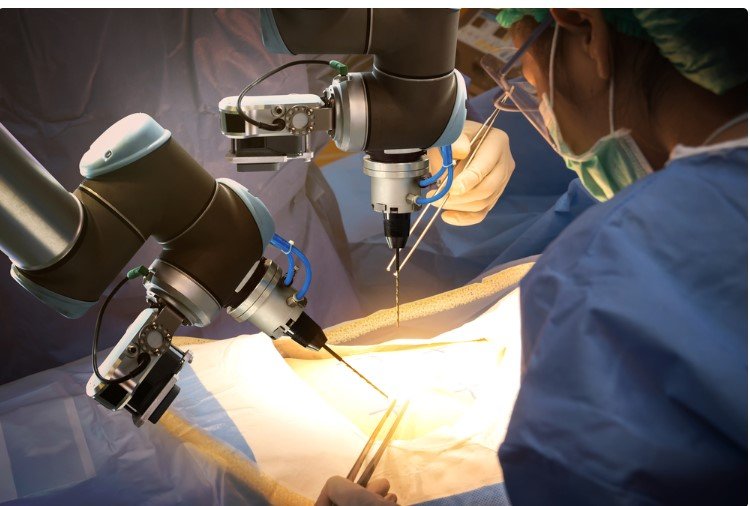Cleaning and Disinfecting Robots:
Cleaning and Disinfecting Robots have become increasingly essential in various industries, especially in healthcare, to ensure thorough and efficient cleaning processes.
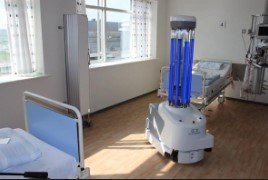
Here are additional insights:
- Market Growth: The market for cleaning and disinfection robots is rapidly expanding, with a projected growth rate of 23.0% per year from 2020 to 2028, reaching an estimated size of US$ 36.05 billion by 2028. This growth is driven by the need for more frequent and comprehensive cleaning due to the COVID-19 pandemic.
- Disinfection Efficiency: Cleaning robots using UV-C light and hydrogen peroxide have been shown to be faster and more effective than manual cleaning methods. They can disinfect surfaces using touchless methods, such as UV radiation, which has been proven effective in killing viruses and bacteria. For example, robots at Sharp Grossmont Hospital can disinfect COVID patient rooms in just 12 minutes, a task that would take human workers 90 minutes.
- Safety Benefits: These robots contribute significantly to keeping cleaning personnel safe by reducing their direct contact with cleaning fluids and contaminated surfaces. Airports, for instance, use UV disinfecting robots to clean high-touch surfaces like handrails, minimizing the potential risks associated with manual cleaning tasks.
- Patient Access Improvement: In healthcare settings like radiology departments, where expensive equipment must be kept clean but unskilled personnel are restricted from touching it, cleaning robots play a crucial role. They enable faster and more efficient disinfection of equipment without human contact, reducing delays in scheduling appointments for patients.
- Floor Cleaning Robots: Robotic floor cleaners have gained popularity, especially in public spaces like restaurants and hotels where cleanliness is a top priority for customers. These robots can autonomously mop, vacuum, and polish floors, contributing to a cleaner environment while relieving some of the burdens on staff.
- Future Development: There is ongoing research and development focused on enhancing the effectiveness of cleaning and disinfection robots. Innovations include combining UV-C light with vaporized hydrogen peroxide for improved disinfection capabilities. Additionally, efforts are being made to address challenges such as long disinfection times and safety concerns related to chemical sprays.
Safety and Monitoring Robots:
Safety and Monitoring Robots play a crucial role in healthcare and various industries to enhance safety, efficiency, and patient outcomes. These robots are designed to monitor patients, track inventory, count medications, and ensure compliance with safety protocols.
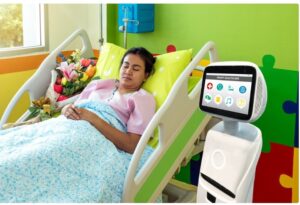
Here are some key points based on the provided sources:
- Design for Safety: When developing Safety and Monitoring Robots, it is essential to consider factors like size, shape, weight, speed, power, and the tasks they will perform. Following relevant standards such as ISO 10218 for industrial robots ensures safety from potential hazards like collisions or electric shocks.
- Mechanical Safety: Ensuring that all moving parts are properly guarded to prevent injuries if contact occurs is vital. Proper guarding mechanisms are essential to protect individuals interacting with these robots.
- Electrical Safety: Implementing precautions to prevent electrical hazards, such as using appropriate wiring and protection from liquids, is crucial for the safe operation of these robots.
- Software Safety: Thorough testing of software to eliminate bugs that could lead to malfunctions is necessary. Ensuring that the software is secure and free of vulnerabilities is key to maintaining the safety of these robots.
- Human-Robot Interaction: Considering how the robot interacts with humans is essential. Preventing unauthorized access to controls and protecting data from breaches are critical aspects of ensuring safe human-robot interaction.
- Monitoring for Maintenance: Regularly tracking the status, performance, and health of these robots is important. Detecting issues early on through inspections, repairs, and updates helps prevent accidents and ensures optimal efficiency
Surgical Robots:
Surgical robots have evolved to assist surgeons in performing complex procedures with enhanced precision and control. These robots do not replace human surgeons but rather act as tools that surgeons can operate remotely with improved dexterity and range of motion. The da Vinci Surgical System, approved by the FDA in 2000, was the first robotic system designed for general minimally invasive surgery

Here are additional insights:
- Robotic surgical assistants allow surgeons to perform minimally invasive procedures with enhanced precision, visualization, and control. These are used for procedures like bariatric, orthopedic, and neurological surgeries.
- Enhanced Visualization and Control: One of the key advantages of surgical robots is their ability to provide surgeons with improved 3D visualization and precise control over surgical instruments. This technology allows for more accurate movements and better access to delicate or hard-to-reach areas within the body, reducing the risk of damage to surrounding tissues.
- Minimally Invasive Procedures: Surgical robots are commonly used in minimally invasive procedures, where small incisions are made, resulting in less pain, reduced blood loss, shorter hospital stays, and faster recovery times for patients. These robots enable surgeons to perform intricate surgeries through tiny keyhole-sized incisions with greater precision.
- Patient Benefits: Patients undergoing robotic-assisted surgery experience several benefits compared to traditional open surgery, including less pain, reduced risk of infection, minimal scarring, shorter hospital stays, and quicker return to daily activities. The advanced technology of surgical robots contributes to improved patient outcomes and overall satisfaction.
- Specialized Robotic Systems: Different surgical specialties utilize robotic systems tailored to their specific needs. For instance, gastrointestinal, cardiothoracic, gynecologic oncology, otolaryngology (head and neck), urologic surgery, spinal neurosurgery, and other specialties benefit from robotic-assisted procedures. Each surgical team undergoes specialized training to operate these robotic systems effectively.
- Future Developments: The future of surgical robots involves integrating cutting-edge technologies like artificial intelligence (AI) to enhance surgical precision and outcomes further. As technology advances, there is a growing trend towards developing more precise and least invasive versions of fundamental surgeries. Research continues to explore ways to combine robotic surgery with other innovative technologies for even better patient care.
Rehabilitation Robots:
Robotic exoske Rehabilitation robots are designed to improve movement in individuals with physical impairments, such as strokes or neurological disorders. These robots assist during therapy sessions, guiding patients through exercises to restore mobility and track their progress. The automation and repeatability of these robots allow for increased exercise intensity, leading to faster recovery and better outcomes compared to manual therapy

- Technological Advances: The integration of haptic technology, artificial intelligence (AI), and intelligent active-assistance features enhances the effectiveness of robotic therapy. Haptic feedback provides intelligent responses to patient movements, while AI helps organize therapy data and predict patient outcomes. Intelligent active-assistance ensures that patients receive the appropriate level of support during motor challenges, optimizing their rehabilitation process.
- Benefits: Robotic therapy offers several advantages over traditional approaches, including standardized training environments, adaptable support, increased therapy intensity, and reduced physical burden on therapists. By providing consistent and repetitive training at prescribed intensities, rehabilitation robots facilitate neuroplastic changes in the brain necessary for recovery after neurologic injuries like strokes. These robots are particularly effective in driving patient outcomes by focusing on repetitions and time in therapy sessions.
- Types of Robotic Devices: Rehabilitation robots can operate passively, actively, or interactively depending on the treatment requirements. Most clinical devices today are active or interactive, providing assistance or resistance based on patient movements. These devices can be used for upper extremity rehabilitation like arm movements or lower extremity rehabilitation for walking assistance. The design of these devices aims to combine specialized engineering with neurophysiological knowledge to optimize patient outcomes.
- Research and Development: Ongoing research focuses on developing more accessible and user-friendly rehabilitation robots. Efforts are directed towards adapting low-cost systems for therapy, increasing remote assessment capabilities through telerehabilitation, virtual environments, and incorporating gaming elements to enhance patient adherence to prescribed training regimens. The goal is to make robotic therapies more widely accessible while ensuring meaningful data collection for assessment purposes.
Robots for Training Medical Personnel:
Robots can simulate patients and procedures, allowing medical professionals to practice skills in a safe, controlled environment.
Robots for Training Medical Professionals
- Simulation Platforms: Robotic systems are increasingly being integrated into simulation platforms to provide realistic training environments for medical professionals. These platforms use AI and virtual reality to simulate surgical procedures, allowing trainees to practice using robotic controls and hone their skills in a safe, controlled setting.
- Realistic Patient Simulation: Advanced robotic patient simulators, like the Hal robot, can mimic a wide range of human vital signs, symptoms, and behaviors. This allows trainees to practice responding to complex medical scenarios, such as respiratory distress or seizures, and develop the necessary clinical skills.
- Repetitive Task Training: Robotic systems can automate repetitive tasks, like suturing or other surgical maneuvers, enabling trainees to practice these skills repeatedly to build muscle memory and dexterity. This is especially useful for developing proficiency with robotic surgical systems.
- Feedback and Assessment: The simulation platforms and robotic patient simulators can track trainee performance, provide real-time feedback, and assess skill development. This data can be used to identify areas for improvement and tailor training programs to individual needs.
- Exposure to Rare Scenarios: Robotic patient simulators allow trainees to encounter rare or high-risk medical situations that they may not experience during regular clinical rotations. This prepares them to respond effectively when faced with such scenarios in real-world settings.5
- Reduced Risk: By practicing on robotic systems and simulators, medical trainees can develop critical skills without putting actual patients at risk. This helps ensure patient safety while allowing trainees to learn and make mistakes in a safe environment.4
- Improved Teamwork: Robotic training platforms can involve multiple trainees working together, fostering improved communication, coordination, and teamwork skills essential for effective patient care.
Social and Telepresence Robots:
Social and Telepresence Robots are transforming various industries by providing remote communication solutions, enhancing healthcare services, improving the quality of life for individuals needing companionship or assistance, and expanding access to education and training opportunities through innovative robotic technologies.
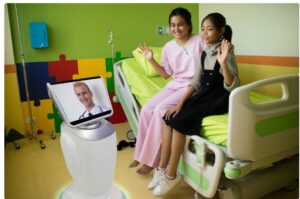
Developments on Social and Telepresence Robots
- Increased Adoption: Social and telepresence robots are seeing increased adoption in healthcare settings, particularly for remote patient monitoring, teleconsultations, and companionship for isolated individuals. These robots help bridge the gap between patients and healthcare providers, especially in rural or underserved areas.
- Elderly Care: Social robots are being used in elderly care facilities to provide companionship, reminders for medication, and assistance with daily tasks. These robots can engage residents in activities, reduce feelings of loneliness, and improve overall well-being.
- Education and Training: Telepresence robots are utilized in medical education and training programs to facilitate remote learning experiences. They allow students to participate in surgeries, consultations, or lectures from anywhere in the world, enhancing access to specialized knowledge and expertise.
- Remote Monitoring: Social robots equipped with sensors can monitor vital signs, detect falls, and provide alerts in case of emergencies for elderly or disabled individuals living alone. This technology enhances safety and allows for timely intervention when needed.
- Customizable Interactions: Advances in AI have enabled social robots to personalize interactions based on individual preferences and needs. These robots can adapt their behavior, speech patterns, and responses to create more engaging and meaningful interactions with users.
- Integration of Emotion Recognition: Some social robots are now equipped with emotion recognition capabilities that allow them to interpret human emotions through facial expressions, tone of voice, or gestures. This enables more empathetic responses and tailored interactions with users.
- Global Market Growth: The global market for social and telepresence robots is projected to continue growing rapidly, driven by increasing demand for remote communication solutions, healthcare applications, and companionship services. This growth is fueled by advancements in robotics technology and AI algorithms.
Patient Transfer Robots:
Patient Transfer Robots play a vital role in enhancing patient safety, improving staff ergonomics, increasing operational efficiency, and providing customized transfer solutions in healthcare settings. These robots contribute to a safer and more efficient patient care environment while supporting healthcare staff in delivering quality care to patients.

Applications and Facts on Patient Transfer Robots
- Assisting Healthcare Staff: Patient transfer robots are designed to assist healthcare staff in safely moving patients between beds, wheelchairs, and other surfaces. These robots help reduce the physical strain on healthcare workers during patient transfers, minimizing the risk of injuries and improving overall ergonomics in healthcare settings.
- Enhanced Patient Safety: Patient transfer robots are equipped with safety features such as sensors to detect obstacles, weight-bearing capacity monitoring, and secure locking mechanisms to ensure safe and smooth transfers for patients. These robots help prevent accidents and injuries during the transfer process.
- Increased Efficiency: By automating patient transfers, these robots can streamline workflow processes in healthcare facilities, saving time and reducing the need for manual lifting and repositioning of patients. This efficiency improvement allows healthcare staff to focus more on patient care and less on physical tasks.
- Customizable Transfer Options: Patient transfer robots offer customizable transfer options to accommodate various patient needs, including different body sizes, mobility levels, and medical conditions. This versatility allows for tailored transfer solutions based on individual patient requirements.
- Integration with Electronic Health Records (EHR): Some patient transfer robots are integrated with electronic health record systems to track patient movements, transfers, and positioning data. This integration helps improve documentation accuracy, streamline data management, and enhance communication among healthcare providers.
- Remote Monitoring Capabilities: Advanced patient transfer robots may feature remote monitoring capabilities that allow healthcare staff to oversee transfers from a distance, providing real-time feedback and intervention if needed. This remote monitoring enhances patient safety and ensures efficient transfer operations.
- Market Growth: The market for patient transfer robots is experiencing steady growth due to the increasing focus on patient safety, staff well-being, and operational efficiency in healthcare facilities. This growth is driven by technological advancements in robotics, rising demand for automation solutions, and a growing emphasis on improving healthcare outcomes.
Delivery Robots:
Delivery robots are automated, self-driving robots designed to transport and deliver various items directly to customers’ doorsteps or designated locations. These robots are essentially mobile containers on wheels that can navigate to their destinations using advanced sensors, cameras, and GPS technology.
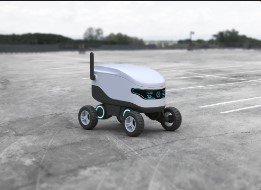
Applications and Facts on Delivery Robots
- Hospital Logistics: Delivery robots are utilized in hospitals to transport medications, lab samples, documents, and other items between different departments. These robots help streamline logistics operations, reduce human error, and ensure timely delivery of critical supplies within healthcare facilities.
- Contactless Delivery: Delivery robots offer contactless delivery solutions, especially during times of heightened infection control measures like the COVID-19 pandemic. By minimizing human-to-human contact in the delivery process, these robots help reduce the risk of cross-contamination and enhance safety for both staff and patients.
- Autonomous Navigation: Many delivery robots are equipped with advanced sensors, cameras, and mapping technology that enable autonomous navigation in complex indoor environments. These robots can safely maneuver through crowded hallways, elevators, and other obstacles to reach their destinations efficiently.
- Efficiency and Productivity: By automating delivery tasks, robots can significantly improve efficiency and productivity in healthcare settings. They can operate 24/7, reducing wait times for deliveries and allowing staff to focus on more critical patient care tasks.
- Inventory Management: Some delivery robots are integrated with inventory management systems to track supplies, restock items, and optimize inventory levels automatically. This integration helps healthcare facilities maintain accurate stock levels and streamline supply chain operations.
- Scalability: Delivery robots offer scalability in healthcare logistics by adapting to varying workload demands. Whether it’s delivering medications to multiple floors or transporting bulky equipment within a hospital complex, these robots can efficiently handle diverse delivery requirements.
- Environmental Impact: Delivery robots contribute to sustainability efforts by reducing the need for traditional delivery vehicles that emit carbon emissions. Their electric-powered operation and efficient route planning help minimize the environmental footprint of logistics operations in healthcare facilities.
- Market Growth: The market for delivery robots in healthcare is witnessing significant growth as more facilities recognize the benefits of automation in improving operational efficiency, reducing costs, and enhancing patient care services. This growth is driven by technological advancements in robotics, increasing demand for contactless delivery solutions, and a focus on optimizing healthcare logistics.
Pharmacy Robots:
Pharmacy Robots play a crucial role in modernizing pharmacy operations by automating medication dispensing, improving inventory management, enhancing patient safety, and increasing operational efficiency in healthcare settings. Their adoption continues to grow as pharmacies seek innovative solutions to meet the evolving needs of patients and healthcare providers.

Applications and Facts on Pharmacy Robots
- Medication Dispensing: Pharmacy robots are used to automate the dispensing of medications in healthcare settings. These robots can accurately count pills, label prescriptions, and package medications for individual patients, reducing the risk of errors and improving efficiency in pharmacy operations.
- Inventory Management: Pharmacy robots help manage medication inventory by tracking stock levels, expiration dates, and usage patterns. By automating inventory management tasks, these robots ensure that pharmacies maintain adequate supplies of medications while minimizing waste and stockouts.
- Prescription Filling: Pharmacy robots assist pharmacists in filling prescriptions by retrieving the correct medications from storage, verifying dosages, and preparing orders for dispensing to patients. This automation streamlines the prescription filling process and reduces wait times for patients.
- Patient Safety: By reducing manual handling of medications, pharmacy robots enhance patient safety by minimizing the risk of medication errors, cross-contamination, and mix-ups. These robots ensure that patients receive the right medications in the correct dosages as prescribed by healthcare providers.
- 24/7 Operations: Pharmacy robots enable pharmacies to operate 24/7 or extend their hours beyond traditional business hours. This flexibility allows patients to access medications at their convenience and reduces delays in receiving essential treatments.
- Integration with Electronic Health Records (EHR): Some pharmacy robots are integrated with electronic health record systems to streamline communication between healthcare providers and pharmacists. This integration ensures accurate medication dispensing based on patient records and enhances coordination of care.
- Cost Efficiency: Pharmacy robots help reduce labor costs associated with manual medication dispensing and inventory management. By automating repetitive tasks, these robots free up pharmacy staff to focus on clinical services and patient care, ultimately improving operational efficiency.
- Market Growth: The global market for pharmacy automation systems, including pharmacy robots, is experiencing significant growth due to the increasing demand for efficient medication management solutions in healthcare facilities. This growth is driven by advancements in robotics technology, rising prescription volumes, and a focus on enhancing patient safety and quality of care.
Diagnostic and Treatment Planning Robots:
Diagnostic and treatment planning robots represent a significant step forward in the integration of technology into healthcare, offering tools that can enhance the accuracy of diagnoses, the personalization of treatment plans, and the efficiency of surgical and rehabilitation processes. As technology advances, these robots are expected to play an increasingly important role in delivering high-quality, patient-centered healthcare.
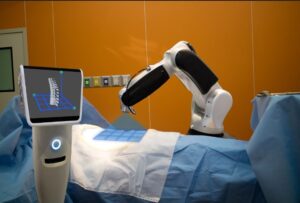
Applications of Diagnostic and Treatment Planning Robots
- Diagnostic Assistance: Robots equipped with AI algorithms can analyze medical images—such as X-rays, MRIs, and CT scans—more quickly and accurately than human practitioners in some cases. They assist in identifying abnormalities, such as tumors or fractures, which can improve early diagnosis rates.
- Precision Medicine: By analyzing vast amounts of genetic data, these robots help in developing personalized medicine plans. They can predict how different patients will respond to various treatments based on their genetic makeup, leading to more tailored and effective care strategies.
- Surgical Planning: Robots are used to plan surgeries, using 3D models to simulate different scenarios. Surgeons can practice the procedure on a virtual model or a 3D-printed physical model, allowing for more precision during the actual surgery.
- Radiation Therapy Planning: In cancer treatment, robots can help plan radiation therapy by accurately mapping where radiation doses should be applied, optimizing the treatment’s effectiveness while minimizing damage to surrounding healthy tissues.
- Rehabilitation Robotics: For patients undergoing rehabilitation, robots can analyze progress and adjust therapy programs in real-time to ensure optimal recovery paths. They can also assist in performing physical therapy exercises, providing support and resistance as needed.
More Detail
Robots in Hospitals: Types, Applications and Advantages (agvnetwork.com)
Application of robotics in the medical field & healthcare (robotnik.eu)
Written by CHARM-retirement.com
Mar-2024

